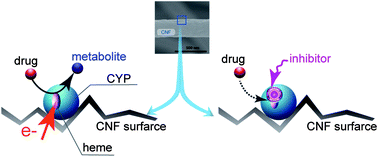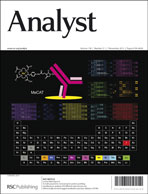Human cytochrome P450 3A4 and a carbon nanofiber modified film electrode as a platform for the simple evaluation of drug metabolism and inhibition reactions†
Abstract
Electrochemical biosensors consisting of cytochrome P450 enzyme modified electrodes have been developed to provide a simple method for screening the metabolism of a drug and its inhibitor. Here, we report a very simple electrochemically driven biosensor for detecting drug metabolism and its inhibition based on cytochrome P450 3A4 (CYP3A4) and a carbon nanofiber (CNF) modified film electrode without any other modified layers such as mediator films. Direct electron transfer (DET) between CYP3A4 and CNFs was observed at a formal potential of −0.302 V. The electrocatalytic reduction current increased with the addition of drugs including testosterone and quinidine. In contrast, the reduction current was greatly suppressed in the presence of ketoconazole, which is a CYP3A4 inhibitor. CNFs with high conductivity, a large surface area and sufficient edge planes provide a suitable microenvironment for achieving excellent DET and biocatalysis properties, which could not be observed when we used other carbon materials such as carbon nanotube (CNT) and carbon black (CB) modified electrodes, indicating that our system is promising as a new bioelectronic platform for electrochemical biosensing.


 Please wait while we load your content...
Please wait while we load your content...